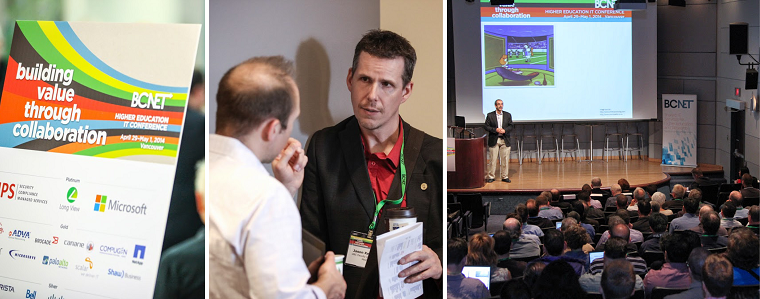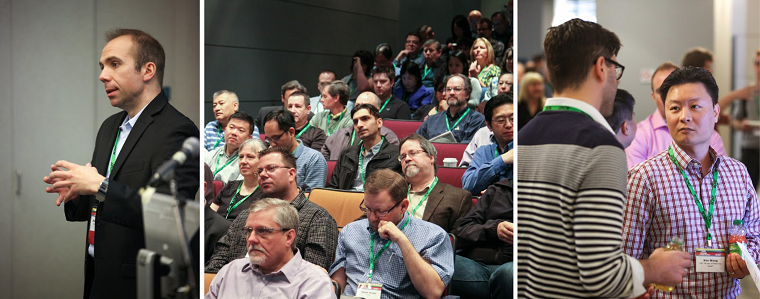
Photos used with permission of BCNET.
Earlier this month professionals in Higher Education IT from across the province gathered at Harbour Centre in Vancouver for the 2014 BCNET Conference. MedIT was there to listen, discuss and share.
The conference covered a variety of hot topics – from BYOD (“bring your own device”), to the cloud, to information security. No matter the technology, two particular themes ran throughout the conference:
Collaboration and Sharing
The goal of the BCNET Conference is to “build value through collaboration.” This emphasis on collaboration was not only evident in many of the session topics, but also in the very atmosphere of the conference.
With a number of recent additions to the BCNET community, along with the merging of the BCNET Conference with the IT4BC Conference, a number of new voices were present this year. With those new voices came more opportunities for shared learning, both in sessions and through one-on-one networking. As one conference attendee from MedIT noted, it was a reminder that “we’re all working toward the same goals, with similar challenges and drivers.”
Many sessions offered were designed to facilitate collaboration and sharing. In his keynote session, Jesse Hirsch, Internet Strategist and Broadcaster, invited people to actively challenge him and debate (or heckle) over Twitter using BCNET’s hashtag #BCNET2014:
About to deliver the opening keynote at #BCNET2014 . Heckling via Twitter encouraged.
— Jesse Hirsh (@jessehirsh) April 29, 2014
This not only kept the conversation going among members of the audience, it allowed for that conversation to spread beyond the walls of Harbour Centre:
“The school is not the bricks and mortar, it’s where the students and teachers are” @jessehirsh #BCNET2014
— Colin Jones (@seejonesrun) April 29, 2014
Wake up each day and ask yourself, ‘what am I going to learn today’. This is arguably the most important trait today. @jessehirsh #BCNET2014
— Trevor Woods (@tjwoods) April 29, 2014
@jessehirsh thinks we need “cognitive authorities” better at explaining technological innovations to those who are not IT pros. #bcnet2014
— Christopher Pryde (@UBCPryde) April 29, 2014
Rapid Change
The second theme that wove its way through various sessions was the rapid pace of change in technology, and what the impacts may be for educational institutions.
With the ever-evolving commercial technology options available to Faculty, staff and students, expectations around service delivery are rising. Two of MedIT’s Senior Managers, Gary Rosborough (Educational Technology) and Anthony Roggeveen (Application Services), delved into the realities of this with their presentation “Delivering Great Service: Keeping Pace with Technology and Expectations.” They shared the challenges they have faced keeping pace, their views on the importance of engaging stakeholders at a human level, and the learner-centred approach that they have taken in order to deliver a satisfying experience with university-supported technology.
Technology changes not only require us to re-think how service experiences are delivered, they require us to re-think how we support teaching and learning as new methods are enabled. The implications of this traverse both digital and physical spheres, which are more connected that they may first appear. The growth on online learning tools and methods have had a very real impact on the physical classroom, as evidenced in the popular discussion panel “Evolution of Learning Design: New Environments for the 21st Century Classroom.” Flipped classrooms, for example, require a more collaborative space than the traditional lecture theatre.
The impacts of rapid technology changes also go beyond the classroom walls. The desire for BYOD and the incorporation of digital tools into various stages of learning can have implications for the wireless infrastructure that supports these. They also lead to questions of funding and governance – both of which were discussed at BCNET 2014.

Photos used with permission of BCNET.
Going forward
As Dr. George Veletsianos, Canada Research Chair in Innovative Learning and Technology, noted in his keynote, “this is nothing new.” As today’s stories about the disruptive power of technology circulate, we should remind ourselves that similar conversations have taken place over other technologies in other times. History demonstrates that technology alone hasn’t determined the course of research and education delivery; a number of social and political factors have also shaped the direction.
This is where the two themes merge. In order to both manage and take advantage of this rapid technological change we must utilize the component we have most control of: the social element. Through sharing knowledge and collaborating through forums such as the BCNET 2014 Conference, we can better determine the direction we take.